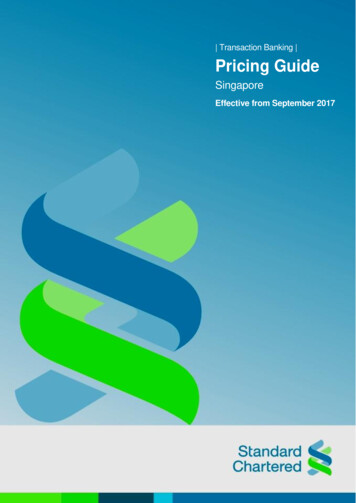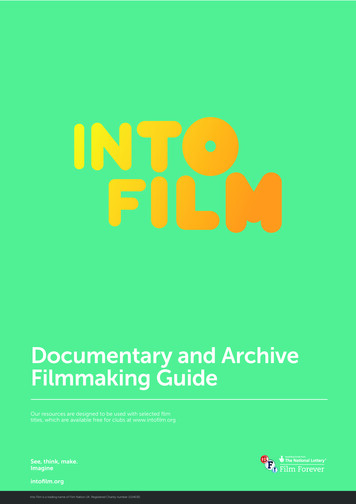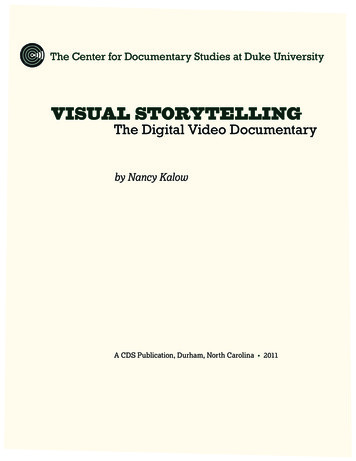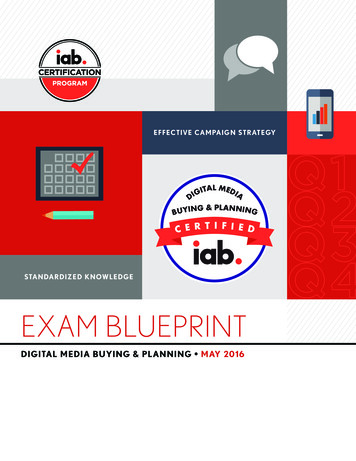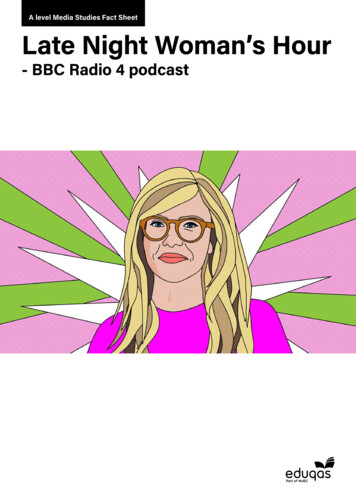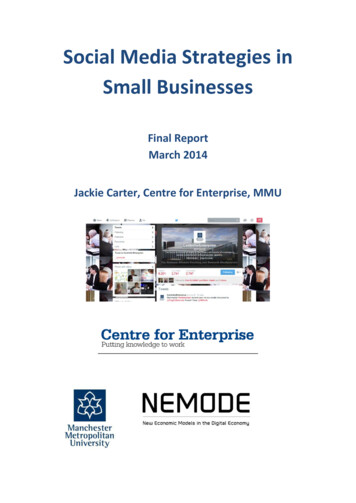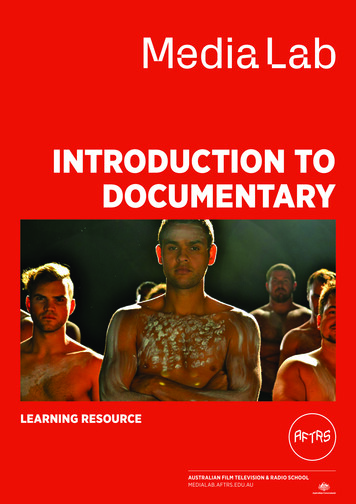
Transcription
INTRODUCTION TODOCUMENTARYLEARNING RESOURCE1AUSTRALIAN FILM TELEVISION & RADIO SCHOOLINTRODUCTION TO .AU
CONTENTS: INTRODUCTION TO DOCUMENTARYSECTION 1Introduction3-5SECTION 2Analysing a Documentary Sequence6-9SECTION 3Interview Skills10-12SECTION 4Camera Techniques13-19SECTION 5Screenwriting20-24SECTION 6Pre-Production Activities25-28SECTION 7Copyright and Safety on Set28-30SECTION 8Sound31-34SECTION 9Data Management and Saving35-37SECTION 10 Editing38-40SECTION 1141-43Presenting and Evaluating your own FilmSECTION 12 Conclusion44-45ABOUT AFTRS’ MEDIA LABAFTRS MEDIA LAB provides accessible media arts resources to Australian primary and secondaryteachers and students. MEDIA LAB will help build core creativity and storytelling capabilities that willbe required for the jobs of the future. The Australian Film TV Radio School (AFTRS) is the nation’sleading screen and broadcast school that delivers future-focused, industry-relevant education,research and training.AUSTRALIAN FILM TELEVISION & RADIO SCHOOLBuilding 130, The Entertainment Quarter, Moore Park NSW 2021PO Box 2286, Strawberry Hills NSW 2012Tel: 1300 131 461 Tel: 61 (0)2 9805 6611 Fax: 61 (0)2 9887 1030www.aftrs.com.au Australian Film, Television and Radio SchoolPublished by the Australian Film, Television and Radio SchoolISSN 0819-2316
SECTION 1INTRODUCTIONThis AFTRS Media Lab Learning Resource and accompanying Teacher Guide provides a practicalintroduction to documentary filmmaking. It provides information, worksheets and suggested activitiesto guide students through the process of preparing for and making a short documentary on a widerange of subjects.As well as encouraging students to identify the ways in which documentaries tell a story or presenta point of view, this resource will help get your class thinking about creative ways to communicateinformation on screen.There isn’t any right or wrong way to use the resource and we hope you’ll be able to tailor it to suityour students’ needs. It can be used in part or as a whole, our aim is that you feel confident andcomfortable teaching documentary filmmaking to your students regardless of your own experiencewith the medium.We recommend that you celebrate your students’ film achievements on completion. Have a screeningin class, get them to watch and talk about each other’s films, help them enjoy the creative process andthe fact that they have made something out of nothing. Film is a powerful medium and we hope bothyou and your students feel a true sense of accomplishment for the work you create.PRACTICAL PREPARATIONBefore you start using this resource, decide on any parameters you will set for your student productions:Theme or styleYou could allow students to make a documentary about anything at all, or you could narrowthe focus either in terms of theme (local history, healthy eating, for and against school uniforms)or genre or style (interview-based, observational, persuasive/campaign).Even if you set an overarching theme it’s recommended that students are given the chance todecide the specific focus of their film. This process could include some brainstorming and it maybe best to do this after the activities in section 1, which are designed to stimulate students’ thinking.DurationIt’s a good idea to give students a maximum length for their completed films. For inexperiencedfilmmakers, a maximum duration of 2 to 4 minutes is recommended.You may also like to set a total limit for the quantity of footage to be shot. If students record fourhours of interviews or observational footage, editing it will be an extremely time-consuming process,whereas working with 20-30 minutes of total footage will take less time.Team size and rolesIt’s recommended that students work in teams of at least two to produce a documentary. You couldassign the roles of producer/director, camera, sound and editor to specific students or alternativelystudents could share or rotate through these roles. Depending on the equipment you use, one personmay be able to operate the camera and sound equipment simultaneously or two people may beneeded. (The FAQ section online provides a suggested list of equipment.)3AUSTRALIAN FILM TELEVISION & RADIO SCHOOLINTRODUCTION TO DOCUMENTARYMEDIALAB.AFTRS.EDU.AU
SECTION 1INTRODUCTIONETHICAL CONSIDERATIONSWhen making a film there are several things a filmmaker must consider in terms of the ethics ofstorytelling. Ethics is “doing the right thing” and means that you must take into consideration otherpeople’s perspectives, how you handle the subject matter and the impact the documentary may haveon the people in your film.Activity 1The questions below give you an idea of the sort of ethical issues you need to be aware of whenmaking a film. Take the time to answer these questions, and share your thoughts with anotherdocumentary maker in the class, to gain their perspective on the story you wish to tell. What is your connection to the subject, whether it’s an individual or community? Do you have arelationship with the individual or do you belong to this community? If not, are you the right personto tell this story? How do I know if I am the right person? Ask the following questions: What is your intention when telling this story? When answering this, consider what you hope toachieve from making this documentary. Do you want people to have more empathy for the subject,are you hoping to achieve a change? What are the positive and negative outcomes of this change?For example, will it get the subject of your documentary in trouble with their friends or family? Willthey find themselves the topic of ridicule? Is it done with the permission of the person and/or community? This is beyond getting them to signa release form. To truly gain permission, it is important that you sit with the subjects and explainyour intentions, and the possible outcomes of telling this story. Remember if you are sharing astory about a particular community, it is very important to consult with diverse voices within thecommunity, as a way of seeking permission from them to tell the story. Make sure one person’sperspective is not skewing the representation of an entire community.Remember, documentary making is a learning process, and unlike fictional work where you can writeexactly the narrative you want to and make actors do as your see fit, you cannot control the subjectsin documentary as much. The characters in documentaries will live their lives long after you’ve finishedworking with them, so it is important to consider how you represent them.4AUSTRALIAN FILM TELEVISION & RADIO SCHOOLINTRODUCTION TO DOCUMENTARYMEDIALAB.AFTRS.EDU.AU
SECTION 1INTRODUCTIONActivity 2Once you have run through the ethical considerations with your class mate, list down your mostsignificant ethical dilemma you have and share it with the class, if you are comfortable.Now as a class, discuss if it possible to resolve this dilemma and if so, then how would it be done.INDIGENOUS PROTOCOLSAustralian storytellers who want to make a film with Indigenous characters, direct a documentaryfocusing on the Indigenous community, or write a script with Indigenous material needs to be familiarwith specific filmmaking protocols and practices. AFTRS has collaborated with some of Australia’smost experienced filmmakers to offer some insights and advice on best practices in this ion5AUSTRALIAN FILM TELEVISION & RADIO SCHOOLINTRODUCTION TO DOCUMENTARYMEDIALAB.AFTRS.EDU.AU
SECTION 2DOCUMENTARYNoun: A film or television or radio program thatprovides a factual report on a particular subjectTo DOCUMENT something, means to capture it. To write it down, photograph it, record it or videoit. You are taking a small piece of real life and keeping a record of it. This may be just for yourself –the way we do with diaries. It may be to share with others – like on Facebook or Instagram. Or it maybe to share information with a much wider audience – the way film and television documentaries do.Documentaries usually have a similar intention – to INFORM the viewer about something theymight not already know. Sometimes they also want to PERSUADE the viewer to have a particularpoint of view.For example nature documentaries will often go into great detail about the life of a particular animalspecies – this is simply to INFORM the viewer about the details of that animal’s life. But sometimesthey might also want to raise awareness about the fact that an animal is endangered and toPERSUADE the viewer to donate money or change their behaviour to help save the animal.Documentary is broadly defined as non-fiction content however generally a documentary film is seento be different from news and public affairs, magazine and talk shows, real world events, docu-dramasand reality television.There are many different techniques used in documentary. Each will have a different effecton the way the story reaches the viewer. Some of these ways of telling a story include: NARRATION – A storyteller tells us the information from off-camera via ‘voice-over’while we watch the visuals. This style helps the filmmaker to share a lot of informationwhile still allowing them to use visual footage. PRESENTER – One person is the face of the documentary, talking to the cameraand sharing information as the film progresses. INTERVIEWS – People may be interviewed by the presenter, or they may just beinterviewed straight to camera. Sometimes the interviews are even used as ‘voice-over’. DRAMATIC RECREATIONS – The documentary will have segments of drama wherepeople will re-enact what happened to show the viewer. These are often used inhistorical documentaries because no real footage exists. STILL PHOTOGRAPHS – A slide show of still photographs will form part of thedocumentary and may have voice-over or music behind it. OBSERVATIONAL – The camera rolls and we just watch it. There is no voice-overor narration of any kind – we see what the camera sees. This is often used fornature documentaries.6AUSTRALIAN FILM TELEVISION & RADIO SCHOOLINTRODUCTION TO DOCUMENTARYMEDIALAB.AFTRS.EDU.AU
Before a filmmaker can make their own documentary, it is important to watch severaland do two things:– Break down the elements of the craft so that you know how to make a good documentarythat does what you want it to do.– Break down the content of the documentary so that you can learn how to decide whatinformation to put into your film.But how do we analyse a DOCUMENTARY? Well, we do a focused viewing where we askquestions as we watch, taking notes and discussing what we find with each other at the end.The sorts of QUESTIONS that it is good to ask of a DOCUMENTARY are:1What is the main focus of the documentary?2 Is it trying to inform us about something or persuade us to believe or do something?3 What style is used? Is it an unfolding story, an interview based documentary,a dramatic recreation? Are there interviews, narration or dramatic recreations?4 Is the documentary promoting any particular viewpoint?5 Does the film making use a variety of different shots to shoot the film or is thecamera usually in just one place?6 Does the documentary use moving footage or still photographs or both?Which of these is the most interesting to you? Why?7 What sort of music and sound effects does the documentary use?8 Does the film succeed in sharing information?9 Is it also interesting and entertaining? Why or why not?10 After watching this documentary, think about meaning. How is it createdby the shots, story, music and audio of the film?Watch the documentaries and fill out the worksheets as you go, particularly focusingon ideas that you like and might use when you create your own documentary.Suggested documentaries for Stage 4:BBC News “Syrian Kids Explain the War”4 minute (interview style, title slates)https://youtu.be/2iz2tNiRpeYABC “Thunderstorm Asthma”4 minute (interview, voice-over, science)https://youtu.be/zluOAlsbI ISBS “First Contact – Elcho Island” (excerpt)3 minute (observational, interview, voice-over)https://youtu.be/bp-9fH6NqR07AUSTRALIAN FILM TELEVISION & RADIO SCHOOLINTRODUCTION TO DOCUMENTARYMEDIALAB.AFTRS.EDU.AU
WORKSHEET NAME:TITLE OF DOCUMENTARYWhat is the focus of the documentary?Is the documentary trying to INFORM us or PERSUADE us? How can you tell?What documentary style is used? Is it an unfolding story, an interview based documentary,a dramatic recreation? Are there interviews, narration or dramatic recreations?Describe the use of different camera angles? How do they help tell the story?8AUSTRALIAN FILM TELEVISION & RADIO SCHOOLINTRODUCTION TO DOCUMENTARYMEDIALAB.AFTRS.EDU.AU
Does the documentary use moving footage or still photographs or both?Which of these is the most interesting to you? Why?What sort of music or sound effects does it use?Is the documentary promoting any particular viewpoint?Is it also interesting and entertaining? Why or why not?Does the film succeed in sharing information?After watching this documentary, what have you learned about whatmakes a good documentary?9AUSTRALIAN FILM TELEVISION & RADIO SCHOOLINTRODUCTION TO DOCUMENTARYMEDIALAB.AFTRS.EDU.AU
SECTION 3GREAT INTERVIEWS AND HOWTO PREPARE FOR FILMING THEMWhen you interview someone your aim is to find out the most interesting things about them.You might want their expertise on a specific topic or you might want stories from their life.Interviews can be a lot of fun and there are ways of preparing for them that will make sureyou are ready and you get the best stories possible.BEFORE YOU GO You are the guide in this scenario and so you need to be prepared with the right tools and a goodplan. Make sure you have all the equipment you need on hand – the camera, sound equipment andany forms you might need to get the interviewee to sign. Its always a good idea to have a pack fullof batteries, notepads, pens and paper too – you never know what you might need.MAKE SURE YOU KNOW WHAT TO EXPECTDo some research on your subject so that you can ask the right questions. Make an outline of theway you want the interview to go. Once you have done that – create a list of questions you want toask. Its great if you can learn these by heart, but write them down just in case. Eventually, with a lotof practice, you can interview people without any pre-prepared questions, but for now – make sureyou have a list. Make sure the questions ask for the right information – they need to provide you withwhat you need to make your documentary.WRITING REALLY GREAT QUESTIONSIt’s a good idea to make groups of questions around themes or around time (in other words,start at the beginning of their life or the story you want them to tell).As you write your questions check if they can be answered with a simple yes or no – if so, changethe question to allow for an “open” response. This means they need to say a few things to answerthe questions, and if they have a lot to say, that will work too. For example – don’t ask “Were you bornin England?” or “Did you go to school” – ask, “What was your first year of school like?”If you need specific information, then your questions can be specific too – “What food do chimpanzeeslike to eat?” This will help you get a lot of facts on the topic. If they are telling a story, you can askthem sensory questions to help make the story deeper and easier to identify with.“What did it feel like to live in the jungle for so many months?”As your interview progresses your questions should also become deeper and more advanced.If you started with “Did you always like to cook?” you can move on to things like “What is it aboutcooking that makes you happy?” It also helps to give your subject a little prod every now and then .“Can you tell me a little more about that?” That way, they know it is fine to keep talking and mightgive you even more great information.10AUSTRALIAN FILM TELEVISION & RADIO SCHOOLINTRODUCTION TO DOCUMENTARYMEDIALAB.AFTRS.EDU.AU
ACTIVE LISTENING IS A WAY OF LISTENING AND RESPONDING TO ANOTHERPERSON THAT IMPROVES MUTUAL UNDERSTANDING. IT INVOLVES FULLYCONCENTRATING ON WHAT IS BEING SAID RATHER THAN JUST PASSIVELY‘HEARING’ THE MESSAGE OF THE SPEAKER. ACTIVE LISTENING REQUIRESTHAT THE LISTENER FULLY CONCENTRATE, UNDERSTAND, RESPOND ANDTHEN REMEMBER WHAT IS BEING SAID.INTERVIEW ETIQUETTEThe same rules apply to interviews as they do to everyday life. Be polite, be on time and be prepared.This shows your subject that you really respect them and they will be more likely to be open withyou in an interview. Make sure you really listen well, no gazing off into the distance or reading yournext question over in your head. Don’t forget that having an interview with someone is like having aconversation – you need to give and take. At the end of the interview, be thankful and tell them whenthe film is likely to be finished.FILMINGBefore you start to film an interview choose your location carefully. Is it quiet? Is it easy to see bothof the participants? Do you need extra light?If you are shooting with a mobile device, do you need extra sound equipment? A microphone on aboom will give you much higher sound quality than the regular device microphone, and sound qualityis very important in film. You may also consider radio microphones if they are available. Practice withthis equipment before the interview so that you know what you are doing and appear professional.Record the entire interview and cut it later. Don’t be tempted to pause and stop and start – this makesit very easy to accidentally miss parts of the interview. You can cut out the bits you don’t need later.Label and save all your footage as soon as the interview is over, keeping at least two copies of it indifferent places. You can also shoot another interview, but it may not be as spontaneous.If you want to put your film online, check with your subject and ask them to give written permission.It is not ethical to put video of someone on the Internet without asking them, and if they are a child –you may need permission from their parents as well.The FAQ section online provides a Release Form.11AUSTRALIAN FILM TELEVISION & RADIO SCHOOLINTRODUCTION TO DOCUMENTARYMEDIALAB.AFTRS.EDU.AU
WORKSHEET NAME:INTERVIEW SKILLSName of interviewer:Name of Subject:Theme of the interview?Location for shooting interview: Describethe set, the noise levels, the lighting etc.Introduction: How will you introduce the subject?5 opening questions:Clothing: what do you want yoursubject to wear? What will you wear?5 more detailed questions:Sound equipment: What are you using?Have you tested it to make sure it works.Write a permission document for the subject to signWhat label did you use for the footage and where did you save it?Write a thank you note for your subject.12AUSTRALIAN FILM TELEVISION & RADIO SCHOOLINTRODUCTION TO DOCUMENTARYMEDIALAB.AFTRS.EDU.AU
SECTION 4CAMERA TECHNIQUESFOR DOCUMENTARYBefore you start to film any scenes, interviews or footage for your documentary it is very importantto understand how the camera can be used to create different feelings for your viewer. Once youunderstand this – you can take better footage that allows you to make the film you want to make. Youcan watch our short video on Camera Techniques to understand these techniques better.These techniques work with all cameras – from a film camera to a DLSR to a mobile device.There are three main things to understand when it comes to camera technique:1 SHOTS2 ANGLES3 MOVEMENTAnd there is one rule that operates across all of filmmaking and photography:THE RULE OF THIRDSThis isn’t actually a rule, just a guiding idea that arises from the fact that the eye prefers to lookat things that are divided into threes. Rather than putting everything in the centre of the frame,it looks and feels better to the viewer for them to be in one or two of the thirds.A great time to use the rule of thirds is when you are shooting an interview. Rather than havingthe eyes of your subject right in the middle of the frame – they should fall into the top/side third,with the subject looking into the empty space on the other side. This feels more natural to the viewer.THERULE OFTHIRDSSHOTSUsing a variety of different shots will make your film more interesting and give you the chanceto manipulate the way your audience feels. Here are some of the main shots that a filmmakercan use to create different effects in their film.13AUSTRALIAN FILM TELEVISION & RADIO SCHOOLINTRODUCTION TO DOCUMENTARYMEDIALAB.AFTRS.EDU.AU
EXTREME WIDE SHOTS (EWS)ACT TO SHOW THE SETTING FOR THE FILMWIDE SHOTS (WS)SHOW THE ENTIRE PERSON OR AREA. THEY’REGREAT FOR ESTABLISHING THE SCENE AND ALLOWROOM FOR THE CHARACTERS TO HAVE SOME ACTIONMEDIUM SHOTS (MS)FRAME THE SUBJECT FROM THE WAIST UP.THIS IS THE MOST COMMON SHOT AND ALLOWSFOR HAND GESTURES AND MOTIONMEDIUM CLOSE UPS (MCU)SHOW THE SUBJECT IN MORE DETAIL AND USUALLYINCLUDE THE SHOULDERS AND HEAD OF A SUBJECTCLOSE UPS (CU)SHOW A PARTICULAR PART OF YOUR SUBJECT –USUALLY THEIR HEAD OR FACEEXTREME CLOSE UPS (ECU)SHOW ONE SMALL DETAIL SUCH AS AN EYEOR A SINGLE FLOWEROVER THE SHOULDER (OSS)ARE SHOT FROM BEHIND THE PERSON TOWARDSTHEIR SUBJECT. THIS IS A GREAT TECHNIQUE TOUSE FOR INTERVIEWS AND CONVERSATIONS14
ANGLESThe difference between a shot and an angle is that THE SHOT is used to demonstratedifferent aspects of the characters and setting, while ANGLES are used to position theviewer so that they can understand the relationships between the characters.BIRD’S EYE ANGLEIS AN ANGLE THAT LOOKS DIRECTLY DOWN UPON A SCENE.THIS ANGLE IS OFTEN USED AS AN ESTABLISHING SHOT,ALONG WITH AN EXTREME LONG SHOT, TO ESTABLISH SETTINGHIGH ANGLEIS A CAMERA ANGLE THAT LOOKS DOWN UPON A SUBJECT.A CHARACTER SHOT WITH A HIGH ANGLE WILL LOOK VULNERABLEOR SMALL. THESE ANGLES ARE OFTEN USED TO DEMONSTRATETO THE AUDIENCE A PERSPECTIVE OF A PARTICULAR CHARACTEREYE LEVEL ANGLEPUTS THE AUDIENCE ON AN EQUAL FOOTING WITH THECHARACTER/S. THIS IS THE MOST COMMONLY USED ANGLEAS IT ALLOWS THE VIEWERS TO FEEL COMFORTABLE WITHTHE CHARACTERSLOW ANGLEIS A CAMERA ANGLE THAT LOOKS UP AT A CHARACTER. THIS MAKESA CHARACTER LOOK MORE POWERFUL. THIS CAN MAKE THE AUDIENCEFEEL VULNERABLE AND SMALL BY LOOKING UP AT THE CHARACTER.THIS CAN HELP THE RESPONDER FEEL EMPATHY FOR THE CHARACTER15AUSTRALIAN FILM TELEVISION & RADIO SCHOOLINTRODUCTION TO DOCUMENTARYMEDIALAB.AFTRS.EDU.AU
MOVEMENTFilmmakers also use camera movement to shape meaning.Tracking shots – any shot where the camera moves alongside the people or objects it is recording.The camera can be mounted on something with wheels or hand-held while the camera operatorwalks or shoots from a moving vehicle.Panning – is used to give the viewer a panoramic view of a set or setting. The camera moveson the horizontal plane left or right. This can be used to establish a scene.Tilting – the camera moves up or down on the vertical plane and this can show a viewer howhigh or deep something is.The best way to become familiar with these is to try shooting them yourself. Use the worksheetto tick off each shot as you take it.SOMETHING ELSE TO REMEMBER: THE 180 DEGREE RULETHE 180 RULE IS A CINEMATOGRAPHY GUIDELINE THAT STATES THATTWO CHARACTERS IN A SCENE SHOULD MAINTAIN THE SAME LEFT/RIGHTRELATIONSHIP TO ONE ANOTHER TO AVOID CONFUSING THE VIEWER. IFTHE CAMERA PASSES OVER THE INVISIBLE AXIS CONNECTING THE TWOSUBJECTS, IT IS CALLED ‘CROSSING THE LINE’.16AUSTRALIAN FILM TELEVISION & RADIO SCHOOLINTRODUCTION TO DOCUMENTARYMEDIALAB.AFTRS.EDU.AU
WORKSHEET NAME:SHOOTING AN INTERVIEWROLES– Interviewer– Interviewee– Camera person– Sound person (optional, remember for this activity you are most interested in the visuals).TOPICChoose a topic for your interview and write 4-6 questions to ask the interviewee.ACTIVITYFind a location where two people can sit quietly, either side by side or opposite one another and setup your camera to capture the interview between the two. Using the tick-boxes below, make sure youhave used ALL of the camera shots at least once. You may also experiment with movement and angleif you like. Don’t forget that it is completely fine to shoot the same question a few times from differentangles – this is what most filmmakers do, to make sure they have all the footage they need.EXTREME WIDE SHOTWIDE SHOTMEDIUM SHOTMEDIUM CLOSE UPCLOSE UPEXTREME CLOSE UPOVER THE SHOULDER SHOT17AUSTRALIAN FILM TELEVISION & RADIO SCHOOLINTRODUCTION TO DOCUMENTARYMEDIALAB.AFTRS.EDU.AU
WORKSHEET NAME:CAMERA TECHNIQUE QUIZ – PART ADRAW A LINE TO MATCH THE IMAGE TO THE CORRECT NAME FOR THAT SHOT1EXTREME CLOSEUP (ECU)2EXTREME WIDE SHOT(EWS)3456718MEDIUM SHOT (MS)CLOSE UP (CU)MEDIUM CLOSE UP(MCU)WIDE SHOT (WS)OVER THE SHOULDERSHOT (OSS)AUSTRALIAN FILM TELEVISION & RADIO SCHOOLINTRODUCTION TO DOCUMENTARYMEDIALAB.AFTRS.EDU.AU
WORKSHEET NAME:CAMERA TECHNIQUE QUIZ – PART BDRAW A LINE TO MATCH THE IMAGE TO THE CORRECT NAME FOR THAT ANGLE123419LOW ANGLEBIRD’S EYE ANGLEEYE-LEVEL ANGLEHIGH ANGLEAUSTRALIAN FILM TELEVISION & RADIO SCHOOLINTRODUCTION TO DOCUMENTARYMEDIALAB.AFTRS.EDU.AU
SECTION 5SCREENWRITINGFOR DOCUMENTARYDocumentary films are much more free-form than drama. This means that while you might havea script to start with – a lot of it will be unknown. It will depend on what footage you get, who youinterview and what they say. So the script you begin with might not be the script you end with and thisis completely normal.It is important, however to have an idea of what you want to achieve, and a basic script to makesure you are on track.THINGS TO REMEMBER ABOUT DOCUMENTARIES BEFORE YOU WRITE A SCRIPT:DOCUMENTARIES DEAL WITH FACTS, NOT FICTION SO YOU WANT TO TRY AND CAPTURETHE MOST ACCURATE VERSION OF THE STORY THAT YOU CAN.DOCUMENTARIES ARE FLEXIBLE SO IF THE STORY STARTS TO GO IN A DIRECTION YOUDIDN’T EXPECT – GO WITH IT.YOUR SUBJECT IS THE MOST IMPORTANT THING SO REMEMBER TO KEEP THE FOCUS ON THEM.QUESTIONS TO ASK YOURSELF BEFORE YOU BEGIN TO WRITE A SCRIPT:– WHY AM I MAKING THIS FILM?– WHAT DO I WANT TO ACHIEVE?– WHO IS MY TARGET AUDIENCE AND WHAT DO I WANT THEIR REACTION TO BE?– HOW MUCH DOES MY AUDIENCE ALREADY KNOW ABOUT THIS SUBJECT?– WHAT SORT OF TECHNICAL CONSTRAINTS DO I HAVE?Most documentaries will have a PLANNING SCRIPT and an EDITING SCRIPT. The planning scriptis written before production and the editing script is written afterwards, once you have the footageand can plan what you want your final film to look like.Once you have your head around these questions you can begin to sketch out ideas for how youwant it to go. Use the template handout to help you match up the visuals you want to capture, withthe potential sound and the timings for the film. The sound might be voice-over (V/O) or interviewor simply music. This will become your planning script.This template is designed around the concept of a documentary focusing on a person, but it caneasily be re-worked for any topic at all. Remember that when you have shot the film you can re-usethis same template to create an editing script.20AUSTRALIAN FILM TELEVISION & RADIO SCHOOLINTRODUCTION TO DOCUMENTARYMEDIALAB.AFTRS.EDU.AU
THINGS TO DO:Read the examples below and discuss the following questions in a group: Why are the scripts formatted like this? Why does the planning script include words the subject MIGHT say? Why write a planning script at all, if it is going to change?Write your own planning script using the worksheet template.Here is a sample of how it can work:FILM: JADE LEE FOOTBALL CHAMPION – EDITING SCRIPTSHOTVISUALSTIMEAUDIO1School yard at recess, kidsrunning and playing. Jadecarries her football throughthe group to the field00:15 secAmbient noise of school yardand V/O Jade: “I’ve playedfootball every single day sinceI was 7 years old.”00:10 secWIDE SHOTJade on football field,kicking ball up the fieldtowards the cameraV/O Jade: “Last year I waspicked for the Primary Schoolstate team and that’s whenthe training really started.”3Jade on bench by thefield for interview00:30 secFace-to-face interviewwith Jade. Questions:EXTREMEWIDE SHOT2MEDIUMCLOSE UP1. W hat sacrifices have youmade to play football atthis level?2. W hat sorts of injurieshave you sustained?3. W hat do you like aboutfootball?4. How did you find outyou have been picked forthe National Junior Team?21AUSTRALIAN FILM TELEVISION & RADIO SCHOOLINTRODUCTION TO DOCUMENTARYMEDIALAB.AFTRS.EDU.AU
FILM: JADE LEE FOOTBALL CHAMPION – EDITING SCRIPTSHOTVISUALSTIMEAUDIO1School yard at recess, kidsrunning and playing. Jadecarries her football throughthe group to the field00:15 secAmbient noise of school yardand V/O Jade: “I play hockeyevery single lunchtime. I havesince Year 2.”00:10 secWIDE SHOTJade on football field,kicking ball up the fieldtowards the cameraV/O Jade: “I was pickedfor the Primary School Stateteam when I was in Year 4and after that I had to trainfive mornings a week at 5am.”3Jade on bench by thefield for interview00:30 secI do football everyday and soI don’t get to do lots of thethings my friends are doing.Like going to the beach orthe mall. And I have to get upearly to travel to games onthe weekend so there are nomovies or parties or anythingfor me. But I love it. I loveevery second of it.EXTREMEWIDE SHOT2MEDIUMCLOSE UPIn my second year I had a badfall and sprained my ankle soI couldn’t play for a whole sixweeks. I thought I’d go crazyjust sitting on the side-lines.Now I’m just more careful.I was picked for the NationalTeam this year which meansI get to represent Australiaat the Pan Pacific Games inOctober. I’m really lookingforward to it, we get amazinguniforms and we all get totravel and live together.22AUSTRALIAN FILM TELEVISION & RADIO SCHOOLINTRODUCTION TO DOCUMENTARYMEDIALAB.AFTRS.EDU.AU
WORKSHEET NAME:DOCUMENTARY SCRIPT: PLANNING/EDITING (CIRCLE N FILM TELEVISION & RADIO SCHOOLINTRODUCTI
introduction to documentary filmmaking. It provides information, worksheets and suggested activities to guide students through the process of preparing for and making a short documentary on a wide range of subjects. As well as encouraging students to identify the ways in which documentaries tell a story or present
